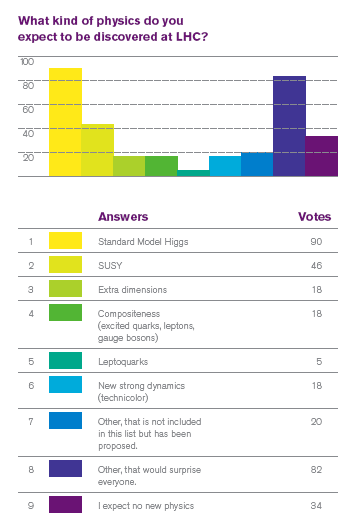
Walking in the dark?
I have been attending hundreds of talks by particle physicists who look for a very specific experimental signature that is predicted by a very specific theory extending the Standard Model. However, I was curious how much faith my colleagues have that what they're looking for can be real. So I asked them in an informal poll.
The chances of certain discoveries looked very low to me, and it seems that the voters agree. The Standard Model Higgs received 90 votes and for many voters was a second tick-mark. (Voters could check multiple answers.) Other potential discoveries received far fewer votes. Supersymmetry, a great “favorite” for some physicists, got only 46 votes. The moral of this, for me, is that unlike the early 90s, when we knew what we were looking for—the top quark that had to be there—now we are walking in the dark.
|
Answers were taken through the fnalgrads@fnal.govmailing list, which reaches graduate students, postdocs, and professors. Each person was able to vote for more than one choice. Voter's IP addresses were recorded to prevent them from voting for the same item twice. |
Something must exist to play the role of the Higgs, but we can only try to guess right now. None of our guesses can be taken very seriously. What will guide our theories will be experimental data. At this point, it makes all the sense to search for the “unknown” in our data. The good thing is that whatever is to be found next, it will be very exciting; even more so than the top quark was.
Georgios Choudalakis, MIT/Fermilab
Click here to download the pdf version of this article.






